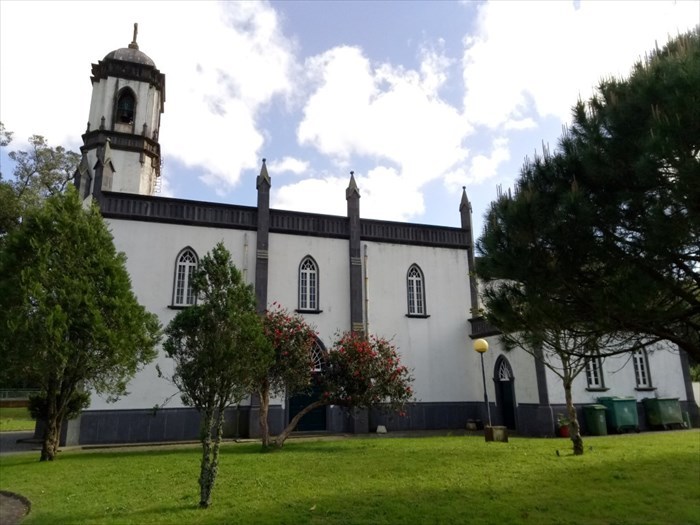-=:=-
Igreja de São Nicolau
PT
“O templo foi mandado erigir em cumprimento de um voto feito em 1849 pelo coronel Nicolau Maria Raposo de Amaral (1770-1865) e sua esposa, Teresa Ermelinda Rebelo (1797-1895). A invocação escolhida foi São Nicolau, bispo de Mira, na Lícia, sepultado em Bari, na Itália, e por isso designado impropriamente como "bispo de Bari".
O terreno escolhido, com 25.000 metros quadrados, havia sido adquirido anteriormente, em 3 de abril de 1834, passando a integrar um morgadio instituído por escritura pública desde 29 de setembro de 1821. O projeto, em estilo neogótico ficou a cargo de Manuel Lamberto Monteiro, que também foi encarregado de dirigir os trabalhos, iniciados em 1849 com o concurso de 60 operários. Foi determinante para a escolha do local do templo uma nascente de água vizinha, o que fez com o templo ficasse relativamente isolado. Para facilitar-lhe o acesso, foi construída uma alameda de criptomérias, encabeçadas por duas hoje imponentes araucárias.
Por escritura de 25 de junho de 1857 o templo foi dotado de uma verba de 2$600 réis anuais para a sua conservação. Posteriormente, em 11 de maio de 1859 recebeu dote para o azeite da lâmpada do Santíssimo Sacramento.
A igreja foi consagrada, em meio a grande festividade, em 16 de agosto de 1857, com missa solene celebrada pelo então bispo da Diocese de Angra, D. Frei Estêvão de Jesus Maria.
Os instituidores mantinham um capelão, para quem mandaram construir o passal, permitindo à população do vale assistir à missa, o que, até então, apenas era possível nas freguesias vizinhas. À época, o lugar das Sete Cidades pertencia às freguesias dos Ginetes e dos Mosteiros, separadas pelo leito da chamada "Ribeira da Praia", que passou a denominar-se, a partir de então, de rua da Igreja.
A lei de 19 de maio de 1863, que extinguiu os morgadios em Portugal, fez com que este templo voltasse à posse dos seus instituidores.
No século XX, os seus herdeiros, não mais desejando conservá-la, doaram-na em 1969 ao povo, pelo que se tornou de sede de curato em sede de paróquia a 23 de maio daquele mesmo ano. Pouco mais tarde, em 1971, as Sete Cidades foram elevadas à categoria de freguesia.”
Fonte
Junto da Igreja existe uma placa informativa onde se pode ler:
"Igreja de São Nicolau
Construída em 1857
De Estilo neogótico foi constrída no século XIX, passando a ser sede de curato e de paróquia na segunda metade do século XX. Foi mandade edificar por Nicolau Maria Raposo Amaral."
EN
“TThe temple was erected in fulfillment of a vote made in 1849 by Colonel Nicolas Maria Raposo de Amaral (1770-1865) and his wife, Teresa Ermelinda Rebelo (1797-1895). The invocation chosen was St. Nicholas, bishop of Mira, in Lycia, buried in Bari, Italy, and therefore improperly designated as "bishop of Bari."
The chosen land, with 25,000 square meters, had been acquired previously, on April 3, 1834, becoming part of a morgadio instituted by public deed since September 29, 1821. The project, in neo-Gothic style was in charge of Manuel Lamberto Monteiro , who was also in charge of directing the work, begun in 1849 with the participation of 60 workers. It was decisive for the choice of the temple site a nearby water spring, which made the temple relatively isolated. To facilitate its access, a mound of criptomies was built, headed by two imposing araucarias today.
By deed of June 25, 1857 the temple was endowed with a grant of 2 $ 600 annual reis for its conservation. Later, on May 11, 1859 he received dowry for the oil of the lamp of the Blessed Sacrament.
The church was consecrated in the midst of great festivity on August 16, 1857, with a solemn Mass celebrated by the then bishop of the Diocese of Angra, Br. Stephen Stephen of Jesus Maria.
The institutes kept a chaplain, for whom they had the passal built, allowing the population of the valley to attend Mass, which until then was only possible in the neighboring parishes. At the time, the place of the Seven Cities belonged to the parishes of the Ginetes and the Mosteiros, separated by the bed of the called "Ribeira da Praia", that denominated, from then, of street of the Church.
The law of 19 of May of 1863, that extinguished the morgadios in Portugal, made that this temple returned to the possession of its instituidores.
In the twentieth century, their heirs, no longer desiring to preserve it, donated it in 1969 to the people, and became the parish priest's office on May 23 of that same year. Shortly afterwards, in 1971, the Seven Cities were elevated to the rank of parish.
Source (Translated with the help of google)
In the historical marker you can read:
"Parish Curch
Built in 1857
This neo-gothic church was buit in the 19th century, becoming the seat of the parish in the 20th century. It was buit under the order of Nicolau Maria Raposo Amaral."
